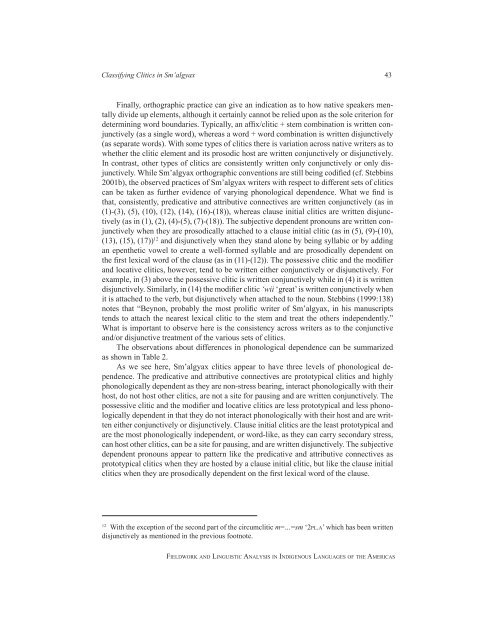Fieldwork and Linguistic Analysis in Indigenous ... - ScholarSpace
Fieldwork and Linguistic Analysis in Indigenous ... - ScholarSpace
Fieldwork and Linguistic Analysis in Indigenous ... - ScholarSpace
Create successful ePaper yourself
Turn your PDF publications into a flip-book with our unique Google optimized e-Paper software.
Classify<strong>in</strong>g Clitics <strong>in</strong> Sm’algyax 43<br />
F<strong>in</strong>ally, orthographic practice can give an <strong>in</strong>dication as to how native speakers mentally<br />
divide up elements, although it certa<strong>in</strong>ly cannot be relied upon as the sole criterion for<br />
determ<strong>in</strong><strong>in</strong>g word boundaries. Typically, an affix/clitic + stem comb<strong>in</strong>ation is written conjunctively<br />
(as a s<strong>in</strong>gle word), whereas a word + word comb<strong>in</strong>ation is written disjunctively<br />
(as separate words). With some types of clitics there is variation across native writers as to<br />
whether the clitic element <strong>and</strong> its prosodic host are written conjunctively or disjunctively.<br />
In contrast, other types of clitics are consistently written only conjunctively or only disjunctively.<br />
While Sm’algyax orthographic conventions are still be<strong>in</strong>g codified (cf. Stebb<strong>in</strong>s<br />
2001b), the observed practices of Sm’algyax writers with respect to different sets of clitics<br />
can be taken as further evidence of vary<strong>in</strong>g phonological dependence. What we f<strong>in</strong>d is<br />
that, consistently, predicative <strong>and</strong> attributive connectives are written conjunctively (as <strong>in</strong><br />
(1)-(3), (5), (10), (12), (14), (16)-(18)), whereas clause <strong>in</strong>itial clitics are written disjunctively<br />
(as <strong>in</strong> (1), (2), (4)-(5), (7)-(18)). The subjective dependent pronouns are written conjunctively<br />
when they are prosodically attached to a clause <strong>in</strong>itial clitic (as <strong>in</strong> (5), (9)-(10),<br />
(13), (15), (17)) 12 <strong>and</strong> disjunctively when they st<strong>and</strong> alone by be<strong>in</strong>g syllabic or by add<strong>in</strong>g<br />
an epenthetic vowel to create a well-formed syllable <strong>and</strong> are prosodically dependent on<br />
the first lexical word of the clause (as <strong>in</strong> (11)-(12)). The possessive clitic <strong>and</strong> the modifier<br />
<strong>and</strong> locative clitics, however, tend to be written either conjunctively or disjunctively. For<br />
example, <strong>in</strong> (3) above the possessive clitic is written conjunctively while <strong>in</strong> (4) it is written<br />
disjunctively. Similarly, <strong>in</strong> (14) the modifier clitic ‘wii ‘great’ is written conjunctively when<br />
it is attached to the verb, but disjunctively when attached to the noun. Stebb<strong>in</strong>s (1999:138)<br />
notes that “Beynon, probably the most prolific writer of Sm’algyax, <strong>in</strong> his manuscripts<br />
tends to attach the nearest lexical clitic to the stem <strong>and</strong> treat the others <strong>in</strong>dependently.”<br />
What is important to observe here is the consistency across writers as to the conjunctive<br />
<strong>and</strong>/or disjunctive treatment of the various sets of clitics.<br />
The observations about differences <strong>in</strong> phonological dependence can be summarized<br />
as shown <strong>in</strong> Table 2.<br />
As we see here, Sm’algyax clitics appear to have three levels of phonological dependence.<br />
The predicative <strong>and</strong> attributive connectives are prototypical clitics <strong>and</strong> highly<br />
phonologically dependent as they are non-stress bear<strong>in</strong>g, <strong>in</strong>teract phonologically with their<br />
host, do not host other clitics, are not a site for paus<strong>in</strong>g <strong>and</strong> are written conjunctively. The<br />
possessive clitic <strong>and</strong> the modifier <strong>and</strong> locative clitics are less prototypical <strong>and</strong> less phonologically<br />
dependent <strong>in</strong> that they do not <strong>in</strong>teract phonologically with their host <strong>and</strong> are written<br />
either conjunctively or disjunctively. Clause <strong>in</strong>itial clitics are the least prototypical <strong>and</strong><br />
are the most phonologically <strong>in</strong>dependent, or word-like, as they can carry secondary stress,<br />
can host other clitics, can be a site for paus<strong>in</strong>g, <strong>and</strong> are written disjunctively. The subjective<br />
dependent pronouns appear to pattern like the predicative <strong>and</strong> attributive connectives as<br />
prototypical clitics when they are hosted by a clause <strong>in</strong>itial clitic, but like the clause <strong>in</strong>itial<br />
clitics when they are prosodically dependent on the first lexical word of the clause.<br />
12 With the exception of the second part of the circumclitic m=…=sm ‘2Pl.a’ which has been written<br />
disjunctively as mentioned <strong>in</strong> the previous footnote.<br />
fieldwork <strong>and</strong> l<strong>in</strong>guistic analysis <strong>in</strong> <strong>in</strong>digenous languages of the americas

















